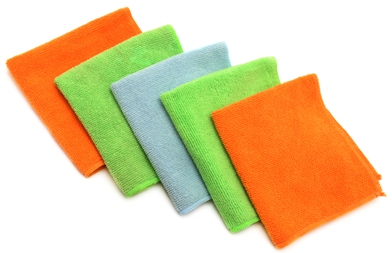 In the world of cleaning essentials, the microfiber cleaning cloth stands out as a true marvel. Its exceptional cleaning power and versatility have made it a must-have tool for homes, offices, and industries alike. With its unique composition and remarkable benefits, microfiber has revolutionized the way we approach cleaning tasks.
In the world of cleaning essentials, the microfiber cleaning cloth stands out as a true marvel. Its exceptional cleaning power and versatility have made it a must-have tool for homes, offices, and industries alike. With its unique composition and remarkable benefits, microfiber has revolutionized the way we approach cleaning tasks.
You likely use a microfiber cleaning cloth everyday to wipe off lint and grime on your eyeglasses and mobile phone screens. Carwash shops use it to buff cars without scratching paintwork and glass. Commercial cleaners use it routinely for office cleaning and facility maintenance. Microfiber has so many practical uses it has become indispensable to every day life.
So, What is Microfiber?
Microfiber cleaning cloths are crafted from a blend of microscopic fibers, usually a mix of polyester and polyamide. Microfiber is about 20 times thinner than silk and a hundred times finer than human hair. It has many applications such as textile for clothing and accessories. This intricate structure also gives microfiber its distinct edge in cleaning efficiency.
The History of Microfiber
Microfiber was first created in the 1950s but did not find much practical use until the 60s and 70s when manufacturing technology allowed more controlled and larger production volume. Dr. Toyohiko Hikota and Dr. Miyoshi Okamoto of Toray Industries are largely credited for developing the microfiber cleaning cloth for industrial uses.
Microfiber is widely used in sports wear because of its unique ability to repel moisture from the body. It is also a popular, synthetic substitute for suede for jackets and fashion apparel because of its sturdy constitution and soft texture. Microfiber is also increasingly used as replacement for leather because it can be printed on and applied with different finishes making it ideal for designer bags, wallets, shoes, and other accessories.
Microfiber cloth, however, finds its greatest use as a cleaning medium. When microfiber was invented in the late 1950s and developed into cleaning cloth beginning in the 70s, it practically revolutionized commercial cleaning because of its ability to absorb oils. Plus, its non-abrasive quality allows deep-cleaning of delicate surfaces such as plasma screens and camera lenses.
How the Microfiber Cleaning Cloth Works
The microfiber cleaning cloth is called split microfiber because of the way it is produced. The fiber is split during manufacturing leaving it with gaps much like how a windmill looks. These gaps allow the fiber to pick-up dirt and oil during cleaning. A split microfiber cleaning cloth can absorb water and oil by as much as eight times its weight.
Microfiber also has electrostatic properties that attract dust and lint. This is because the fiber is charged positive and acts like a magnet pulling negatively charged dust and lint.
Superior Cleaning Power
Microfiber’s remarkable cleaning ability is owed to its microscopic fibers. When used for cleaning, these fibers create a vast surface area that captures and traps dirt, dust, and grime particles much more effectively than traditional materials. The cloth’s capillary action draws in and locks away debris, leaving surfaces remarkably clean and streak-free.
Versatility Redefined
Microfiber cleaning cloths are incredibly versatile. They can be employed on a wide range of surfaces, including glass, countertops, stainless steel appliances, electronic screens, and even delicate surfaces. Unlike rougher materials that can scratch or damage surfaces, microfiber’s soft composition ensures gentle yet efficient cleaning.
Eco-Friendly Cleaning Solution
One of the noteworthy attributes of microfiber cleaning cloths is their eco-friendliness. These cloths often require only water for effective cleaning, minimizing the need for harsh chemical cleaners that can be harmful to the environment. This makes them an excellent choice for individuals and businesses aiming to adopt more sustainable cleaning practices.
Longevity and Durability
Microfiber cleaning cloths are built to last. Their durable construction ensures that they can withstand frequent use and washing without losing their cleaning efficiency. Proper care, such as washing them separately from lint-producing fabrics and avoiding the use of fabric softeners, can further extend their lifespan.
Caring and Maintaining Microfiber Cleaning Cloths
To maximize the lifespan and effectiveness of microfiber cleaning cloths, it’s crucial to maintain them properly. Regularly washing them in cold or warm water and avoiding high heat drying will help preserve their unique properties.
In conclusion, microfiber cleaning cloths have redefined the way we approach cleaning tasks. With their remarkable cleaning power, versatility, eco-friendliness, and durability, these cloths have earned their place as an indispensable cleaning companion. From household chores to professional cleaning applications, the marvel of microfiber continues to shine, providing us with a more efficient and sustainable way to achieve sparkling clean surfaces.

